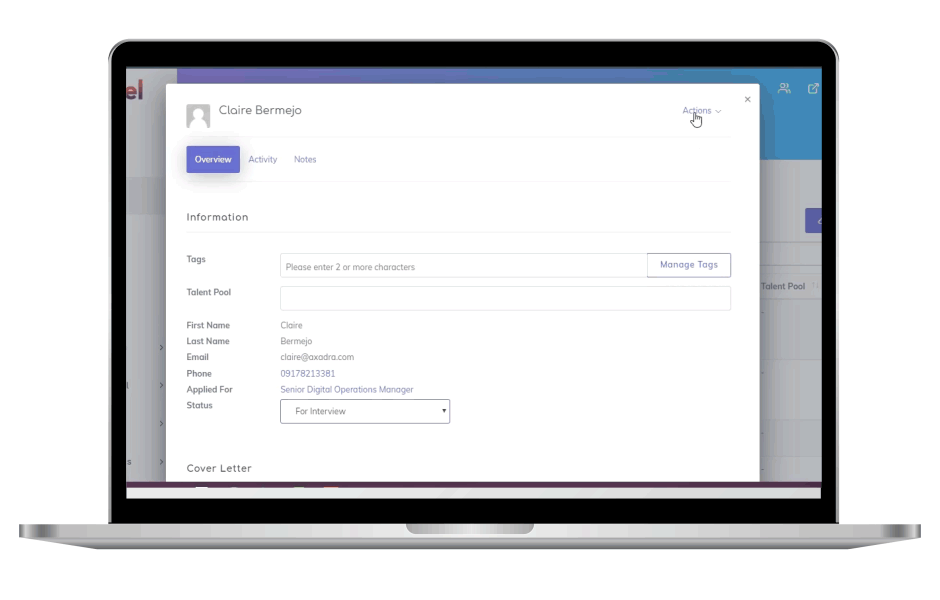Regular recruitment is already a challenge in and of itself, but what happens when you need to hire at scale? As organizations strive to fill numerous positions quickly, you may encounter unique challenges that could make the task daunting, especially when you’re dealing with a competitive labor market.
What Regular Recruitment Looks Like
Regular recruitment typically involves a structured approach to filling a few positions at a time, often focusing on specific skill sets and candidate qualifications. This is a familiar process for most HR professionals and is not as urgent as high-volume hiring. Recruiters can devote a significant amount of time and resources to each candidate to ensure they are the best fit for the role.
In regular recruitment, the number of applicants is manageable enough to be handled manually. However, automating your recruitment can be a game-changer regardless of the amount of applications. It’s a great way to streamline the process and get better results with less effort.
In this scenario, the recruitment team must quickly screen these applications, conduct interviews, and make hiring decisions while maintaining quality standards. They must shift their focus from detailed individual assessments to managing and processing several applications promptly. The process involves:
- Job Advertising: Post job openings across multiple platforms to attract a large pool of candidates.
- Application Screening: Use automated tools to filter applications based on predefined criteria.
- Candidate Assessment: Conduct assessments and interviews at scale to evaluate the skills, experience, and culture fit of candidates.
- Selection and Onboarding: Select the best candidates, sign contracts, and ensure a smooth onboarding process.
As you can probably notice, regular recruitment and bulk hiring follow similar steps. However, high-volume hiring introduces greater urgency and increased mental and physical demands on recruiters, as they must manage a larger influx of applications and expedite the process to meet immediate staffing needs.
Challenges in High-Volume Recruitment
Mass hiring creates a fast-paced environment that can lead to overwhelming administrative tasks and increased pressure on recruiters to deliver results. In these conditions, recruiters tend to overlook or take for granted several critical aspects, which can lead to inefficiencies and pitfalls in recruitment. To effectively deal with these issues, set your expectations and make the necessary preparations and adjustments to your recruitment workflows.
Here are some of the challenges you can expect:
1. Volume of Applications
One of the most significant challenges in high-volume hiring is managing the sheer number of applications coming in. Organizations can attract hundreds or even thousands of applicants for a single position, particularly for low-barrier roles. This makes it difficult for recruiters to identify qualified candidates among a sea of applicants, many of whom may lack experience or have applied just to take their chances.
2. Time to Hire
High-volume hiring is constrained by tight deadlines. Recruiters find themselves racing against the clock to fill positions. The pressure to hire within a set timeframe can force recruiters to make rushed decisions. A slow recruitment process may also discourage applicants from pursuing their applications and moving on to the next hiring stages.
3. Quality of Hire
Due to the large number of positions that need to be filled, recruiters tend to focus on the sheer amount of hires rather than the actual quality of the candidates. This can result in overlooking qualified individuals who may not fit the immediate hiring criteria but possess valuable skills and potential.
4. Consistency
For organizations with multiple locations, decentralized hiring can create inconsistencies throughout the recruitment process. Each location may have its own HR team and protocols. Recruiters may struggle with distributing the labor force equally, meaning some locations may have too many applications while others don’t have enough. Maintaining consistency in candidate evaluation and selection not only simplifies and standardizes hiring but also ensures fairness and objectivity.
5. Candidate Experience
In the rush to fill positions, recruiters may neglect the importance of maintaining a positive candidate experience. Regardless of your staffing needs, candidates still expect timely and personalized updates about the status of their applications. Lack of feedback can leave a poor impression of the employer brand and push candidates to disengage from you. As a result, you can lose top talent and be forced to start all over again.
6. Bias in Selection
The pressure to hire quickly can lead to unconscious biases that cloud decision-making. Recruiters might resort to what’s familiar to them or make hasty judgments, which can result in missing out on diverse talent.
7. Reliance on Manual Processes
Even in high-volume recruitment, some HR professionals continue to rely on manual processes. This increases the likelihood of errors, which automated tools like an ATS can mitigate. Mass hiring also generates a vast amount of data. Without effective tracking systems, the data can get disorganized and underutilized.
8. High Turnover
Many new hires leave shortly after starting due to misaligned job expectations, inadequate onboarding, or a poor cultural fit. This disrupts operations and team dynamics and also incurs additional costs down the line due to finding and training replacements.
9. Data Utilization
HR professionals often overlook the value of data. Data-driven insights can help recruiters identify bottlenecks that will guide them in formulating a high-volume recruitment strategy.
High-Volume Recruitment Strategies
Ultimately, you can’t use the same approach for mass hiring as you do for regular recruitment. When creating an overall high-volume recruitment strategy, you have to think long-term. It’s crucial to look at the bigger picture instead of being reactive to challenges or problems as they arise.
These 7 high-volume hiring solutions will help you scale your efforts during peak recruitment periods:
Choose Quality Over Quantity
Without a structured approach to assessing candidates’ skills and fit, the likelihood of hiring individuals who do not meet performance expectations increases. This can negatively impact team morale and productivity, as well as increase future hiring costs due to turnover.
Conduct Structured Interviews
Structured interviews ensure that all candidates are asked the same set of questions in a specific order. This ensures fairness and objectivity in comparing candidates’ answers as everyone is evaluated based on the same criteria. By asking standardized questions and using a scoring rubric, recruiters will be able to quickly select the most qualified applicants. Structured interviews are highly beneficial in high-volume hiring where time is of the essence. This way, recruiters can pick the most promising candidates without compromising on the quality of hire.
Source Your Existing Talent Pool
Maintain a database of past applicants, former employees, and candidates who have shown interest in your organization. This pool can be tapped into when new positions arise, reducing the time spent on sourcing new candidates.
Tap Into Your Networks
While you can use social media such as Facebook and LinkedIn to post open roles, the “spray and pray method” isn’t the best strategy when mass hiring. Consider tapping into your employees’ personal networks to source talent. Encourage current employees to refer candidates, and, if possible, provide incentives for every successful referral.
Use Data Analytics
Data analytics can transform high-volume hiring by providing insights that drive better decision-making. By analyzing past hires, organizations can determine which attributes correlate with high performance, allowing recruiters to focus on candidates who fit these profiles. You can also use the data to track key performance indicators (KPIs) such as time-to-fill, cost-per-hire, and candidate quality.
Automate Manual Processes
Technological advancements have transformed the way recruiters do talent acquisition. Majority of recruitment tasks can now be automated, making the entire process more efficient. As much as possible, the only stages that require human input are the interviews and the hiring decisions. Automation speeds up your workflow and takes the burden of manual work off your HR team.
Invest in an Applicant Tracking System
ATS can simplify mass hiring in many ways. First, it consolidates all hiring activities into a single platform, which includes features such as filtering applications, tracking candidate’s progress in the hiring lifecycle, and organizing and storing candidate information. Second, it has collaboration tools so that members across departments are updated about changes and hiring decisions in real-time. Third, an ATS automates many aspects of recruitment, from job posting to application screening.
Effortless Hiring with an ATS
High-volume recruitment comes with its own set of hurdles. But with these strategies, you can build a skilled and engaged workforce—no matter the amount of open positions in your organization. The key is to adopt a digital-first and applicant-centric approach, harnessing the capabilities of automation tools and keeping the candidate experience top of mind.
So the next time your team hires at scale, make sure to use an applicant tracking system (ATS). Skillfuel’s ATS provides essential features that streamline the hiring process, allowing organizations to efficiently manage high volumes of applications while maintaining a focus on quality and candidate experience.
Sign up for a FREE version of our software today!















